|
|
Hoosac Tunnel: Abode of the Damned?
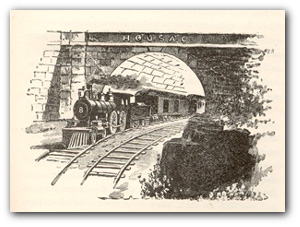
An Exploration of the "Bloody Pit"
Article & Pictures
Site Visit: October 14, 2002 by Daniel V. Boudillion & Andrew T. Bowers
|
Introduction:
The Hoosac Tunnel, a railroad
tunnel beneath the Berkshire Mountains in Western Massachusetts, is said to be
one of the most haunted places in New England. It was an engineering marvel
of its age, completed in 1875, and nearly five miles in length. Yet, it would
cost 195 lives in various fires, explosions, and tunnel collapses, hence
earning its name among the crew at the "Bloody Pit." It has been the scene
ever since of hauntings . . . and even murder.
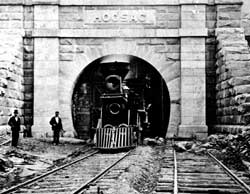
West Portal
History:
The Hoosac Tunnel was first proposed
in 1819 as an underground canal beneath the Berkshires in Western
Massachusetts as a way of providing the through traffic of goods and raw
materials between Boston and points West. A specially appointed
Legislative Commission of 1825 reported: "There
is no hesitation, therefore, in deciding in favor of a tunnel; but even if its
expense should exceed the other mode of passing the mountain, a tunnel is
preferable, for reasons which have been assigned. And this formidable barrier
once overcome, the remainder of the route from the Connecticut to the Hudson
presents no unusual difficulties in the construction of a canal, but in fact
the reverse; being remarkably feasible."

Profile of the Hoosac Mountain and Proposed
Tunnel
The situation of the day was that
there were no direct means between the finished goods coming out of Boston
and the raw materials of the West. The Berkshire Mountains were a decided
barrier to commerce. With the advent of steam locomotion the tunnel plan
was revaluated and re-proposed for railway traffic. Work was officially
commenced in 1851 by the
Troy and Greenfield
Railroad Company, "to build a railroad from the terminus of the Vermont
and Massachusetts, railroad, at or, near Greenfield, through the valleys
of the Deerfield and the Hoosac to the State line, there to unite with a
railroad leading to the city of Troy."
It was to take 24 years and $21,241,842 dollars to complete. There
were innumerable problems encountered, and new technology, both successful
and unsuccessful, was employed to meet the challenge.
Cutting the Tunnel & Construction
Facts
Initially the tunnel was to be
constructed using a 70-ton steam-driven boring machine "designed
to cut a groove around the circumference of the tunnel thirteen inches
wide and twenty-four feet in diameter, by means of a set of revolving
cutters. When this groove had been cut to a proper depth the machine was
to be run back on its railway; and the centre core blasted out by
gunpowder or split off by means of wedges."
The South Boston built
$25,000 machine cut a very smooth and beautiful hole into the rock for
about ten feet, and then it stopped forever.
This failed original tunnel
opening can be seen to the right of the East Portal.
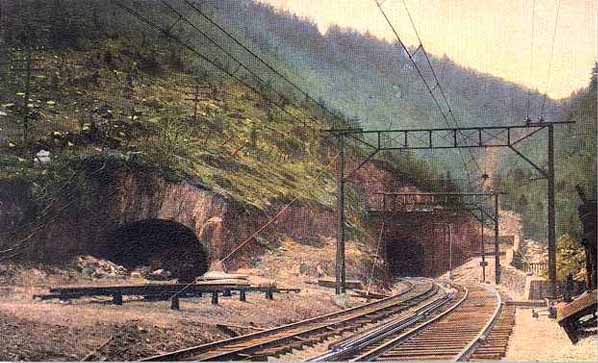
Failed First Attempt on the Left
Following this failure,
the work was for a long time done by means of hand-drills and gunpowder.
But it was found that the most rapid progress that could be made with
hand-drills, under the most favorable circumstances, would not exceed
sixty feet a month at either Portal. This problem led to the introduction
of the compressed air Burleigh Drill, invented by Mr. Charles Burleigh, of
Fitchburg Massachusetts.
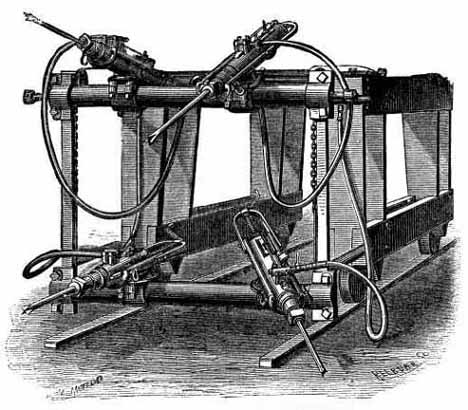
Burleigh Drill
The Hoosac Tunnel was the first
commercial application of Nitroglycerine. Nitro proved to be a very
powerful and extremely unstable explosive that resulted not only in
successfully blasting the length of the tunnel, but in killing dozens of
men in its use.
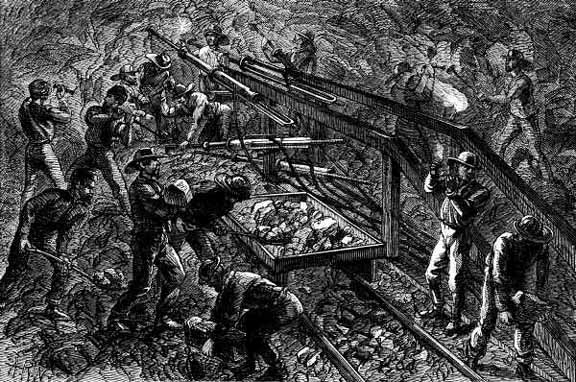
At Work in the Hoosac Tunnel
The tunnel was constructed by
driving two headings, one from the East and one from
the West. The total length of the tunnel is
4.82 miles long. The precision of the work was such that when the
headings met after approximately 2.5 miles of drilling each, the offset
error was approximately Ĺ inch. The original finished size of the tunnel
was 24 feet wide and 20 feet in height. However, recent work was begun in
1997 to grind an extra 15 inches to the height.
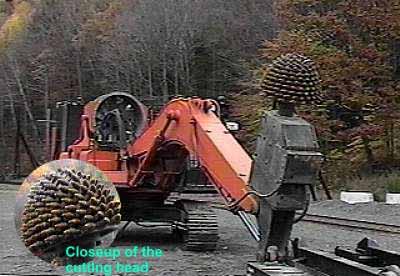
Grinding
Equipment
Photo by
Tom Freeman
The extraordinary job of aligning the tunnel and
keeping it on track to within 1/2 inch was due in part to the erection of
alignment towers on the East and West peaks above the proposed route of
the tunnel below. The below pictured tower is from the west peak
area, recently visited and photographed by noted regional expert
Jim Moore.
A second tower is said to exist in the east peak area.

West Peak Alignment Tower
Photo courtesy of Jim Moore
The tunnel, epically
in the Western portion, was run through
disintegrated mica
schist, which dissolved readily in water (of which there was plenty), and
was "utterly unmanageable." This horrible mixture of disintegrated rock
and water was referred to as "porridge." So much of the tunnel was beset
with soft rock and water problems that the only solution was to brick the
tunnel in long tubes of brick-work. In the end, over 30% of the tunnel
was sheathed in six foot thick brick walls and arches that required the
use of over 20,000,000 bricks.
Due to the difficulties of "porridge" at the the
West Portal, a second shaft was sunk about a half mile further up the
proposed line of the tunnel. This shaft, known as the West Shaft,
bypassed most of the gravel and water and allowed tunneling to advance
from the west at a steady pace. The depth of the shaft was 318 feet,
and was elliptical. The dimensions of the ellipse were 14 feet
east/west, and 8 feet north/south. The site of the shaft head was
located behind and up from a spur created of refuse rock dumped from
tunnel.
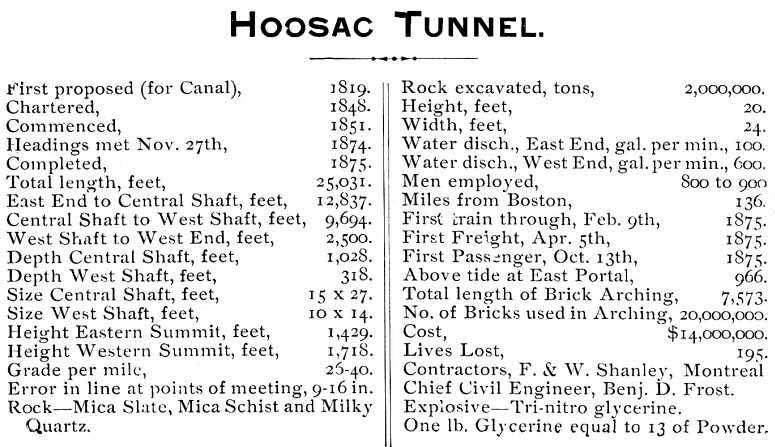
Hoosac Tunnel Final Specifications
The average depth of the tunnel
is about 1400 feet beneath the Hoosac Mountains, with the deepest point
being beneath the Western summit at 1718 feet - approximately 1/3 of a
mile.
There is a slight
grade to the tunnel resulting from an incline angling up
from both Portals to an apex at the middle near the opening of the Central
Shaft. The grade is very minor, rising only about twenty feet over 2.5 miles to facilitate the
runoff of water, which is omnipresent in the tunnel. Were it not for the
slight grade, you would be able to see pinpoints of light at both ends of
the tunnel from the middle point of the tunnel.
The construction manpower in
creating the tunnel was supplied almost entirely by Irishmen supplemented
with some Cornish miners for a typical work force of about 800 to 900
men.
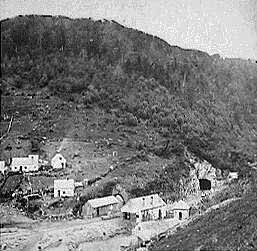
East Portal Work Camp
Central Shaft & Disasters:
The Central Shaft was built somewhat of an afterthought, as a means
of ventilating the anticipated heavy coal exhaust expected to be built up
in the tunnel from locomotive traffic. The shaft is 1028 feet deep and
elliptical in diameter, the ellipse being 27 feet east/west, and 15 feet
north/south. The shaft reached the tunnel in August of 1870.
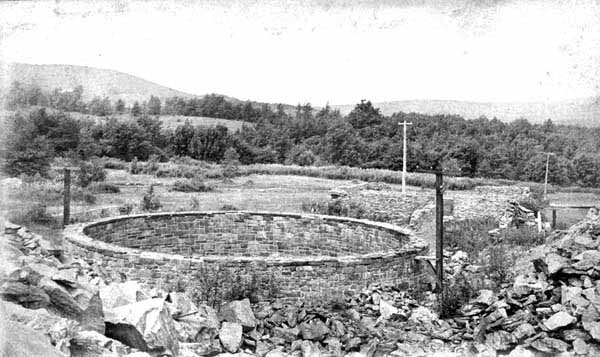
Central Shaft Head
When it was finally connected to the tunnel, the shaft was used to
hoist rock and ferry workmen in large copper buckets. The buckets
were attached to cross-bars of wood, which slide in a frame-work, of timber, thus preventing it from swinging
back and forth in its passage. A steam engine was used to hoist the
bucket at a rate such that the 1030 foot descent was a matter of but two
minutes. The miners "ride to and from their work, sometimes sitting
in the bucket, and sometimes standing on its rim, or on the cross-bars,
and holding on by the cable. Most of those at the central shaft are
Cornish miners, and their life-long experience in such holes in the ground
has made them reckless of danger. The fatal accidents that frequently
occur among them have no effect to in make them more cautious. When the
whistle blows for the 'shift' of hands, every man at the bottom wants to
come up in the first bucket, and generally the whole dozen of them do all
come up at once, two or three sitting in the bucket, and the rest standing
on the rim and the cross-bars, and clinging fast. If a man can get one
foot on the cross-bar and one hand on the cable, he had much rather come
up in that way than wait three minutes for the bucket to return for him."
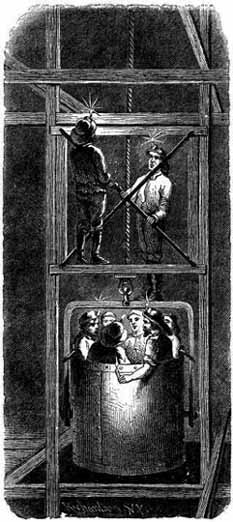
Descending the Central Shaft
A second description of descending the Central
Shaft is from N. H. Eggleston witting in the March 1882 Atlantic
Monthly: "At every descent of the bucket it seemed as though those in
it were being dashed down the dark pit to almost certain destruction.
Speed was necessary, and the machinery was so arranged that the descent of
over a thousand feet was made in a little more than a minute. The
sensations experienced by those who descended the shaft were peculiar.
First, there was the sensation of rapid, helpless falling through space in
the darkness; then, as the speed was at last abruptly arrested, it seemed
for a moment as though the motion had been reversed, and one were being as
rapidly elevated to the surface again."
The Central Shaft was the scene of some the worst accidents in
building the tunnel. On October 17, 1867, an ill designed lamp called a "Gasometer"
leaked Naphtha fumes into the hoist house where it subsequently exploded,
sending the building up in flames. Thirteen men from subcontractor Dull,
Gowan, & White were working in the then 538 foot deep shaft at the time.
The first thing to things to fall on them were more than 300 newly
sharpened drill bits, followed by the hoist mechanism and burning sections
of the structure. With the collapse of the structure, the air-pumps
ceased working and, "Öthe poor fellows all perished there in the darkness.
Nobody knows how soon, or by what means they became aware of the danger
they were in; nor is it certainly known in what manner they died, but the
more probable conjecture is that they were suffocated."
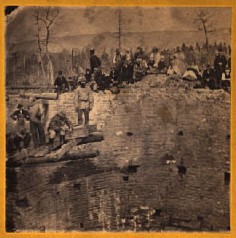
Destruction of the Central Shaft
A fifty year old workman named Mallory who had superintended the
timbering volunteered to be lowered into the shaft. At 4:00 a.m. a rope
was fastened round his body and three lanterns were attached to him. He
passed out near the bottom of the shaft, but reported on recovery that there was no
hope for survivors as he was able to see nothing but water and burnt
timbers.
Within a few days the shaft filled with water and it was not until
a full year later that the shaft was fully emptied and bodies were
recovered. It was
discovered that not all the men had been crushed by the falling debris,
some had managed to build a raft but died from asphyxiation from the
fumes.
Open for Business
When the Hoosac
tunnel was officially opened on October 13, 1875, with the transit of a
passenger car of tourists, it was the one of the longest tunnels in the
world at 4.82 miles, second only to Mont Cenis in the Swiss Alps which
opened 4 years earlier and was 8.5 miles long. It was, however, the
longest tunnel in North America from 1871 to 1916, and is still the
longest transportation
tunnel east of the Rocky Mountains.

Ghost Stories:
Hoosac is a Native American word
for the region meaning "a stony place," and was considered by them an area
of sinister reputation.
So many were the deaths
involved in its construction that the Hoosac Tunnel that it was referred
to among the crew as the "Bloody Pit." After the accidents began piling
up many workers came to
feel that the tunnel was cursed and many of them refused to enter it
again. Some of the crew members simply walked off the job and did
not return.
Murder?
On the afternoon of March 20,
1865, three explosive experts named Ned Brinkman, Billy Nash and Ringo
Kelley decided to use nitroglycerine to continue their work on the
tunnel. They placed a charge and then ran back toward a safety bunker
that would shield them from the effects of the blast. Brinkman and Nash
never made it there however. For some reason, Ringo Kelley set off the
charge before the other men could make it to shelter. The two men were
buried alive under tons of rock.
Soon after the accident, Kelley
vanished without a trace, leading many to believe that the "accident" with
the nitro may not have been an accident after all. He was not seen again
until March 30, 1866 [almost exactly one year later] . . . when his body was discovered two miles
inside of the tunnel. It was found at almost the exact spot where
Brinkman and Nash had been killed. The authorities quickly deduced that
Kelley had been strangled to death. Deputy Sheriff Charles F. Gibson
estimated that he had been murdered between midnight and 3:30 AM that
morning. The death was thoroughly investigated but no suspects were ever
found and the crime went unsolved.
Restless Spirits?
 In 1868 Mr. Dunn of the Hoosac Tunnel construction company reported that
workers "complained constantly of hearing a manís voice cry out in agony"
and refused to enter the half-completed tunnel after sundown
Dun and associate Paul
Travers investigated: "Dunn and I entered the tunnel at exactly 9:00
p.m.. We traveled about two miles into the shaft and then we stopped to
listen. As we stood there in the cold silence, we both heard what truly
sounded like a man groaning out in pain. As you know, I have heard this
same sound many times during the war. Yet, when we turned up our the
wicks on our lamps, there were no other human beings in the shaft except
Mr. Dunn and myself. Iíll admit I havenít been this frightened since
Shiloh. Mr. Dunn agreed that it wasnít the wind we heard. ... I wonder?"
In 1868 Mr. Dunn of the Hoosac Tunnel construction company reported that
workers "complained constantly of hearing a manís voice cry out in agony"
and refused to enter the half-completed tunnel after sundown
Dun and associate Paul
Travers investigated: "Dunn and I entered the tunnel at exactly 9:00
p.m.. We traveled about two miles into the shaft and then we stopped to
listen. As we stood there in the cold silence, we both heard what truly
sounded like a man groaning out in pain. As you know, I have heard this
same sound many times during the war. Yet, when we turned up our the
wicks on our lamps, there were no other human beings in the shaft except
Mr. Dunn and myself. Iíll admit I havenít been this frightened since
Shiloh. Mr. Dunn agreed that it wasnít the wind we heard. ... I wonder?"
 Glenn Drohan, the correspondent who had first covered the 1867 Central
shaft disaster for the Transcript wrote: "During the time the
miners were missing, villagers told strange tales of vague shapes and
muffled wails near the water-filled pit. Workmen claimed to see the lost
miners carrying picks and shovels through a shroud of mist and snow on the
mountaintop. The ghostly apparitions would appear briefly, then vanish,
leaving no footprints in the snow, giving no answer to the minerís calls."
Glenn Drohan, the correspondent who had first covered the 1867 Central
shaft disaster for the Transcript wrote: "During the time the
miners were missing, villagers told strange tales of vague shapes and
muffled wails near the water-filled pit. Workmen claimed to see the lost
miners carrying picks and shovels through a shroud of mist and snow on the
mountaintop. The ghostly apparitions would appear briefly, then vanish,
leaving no footprints in the snow, giving no answer to the minerís calls."
 On the night of June 25, 1872 Dr. Clifford J. Owen and James R. McKinstrey
the drillings operations superintendent traveled about two miles into the
tunnel and then halted to rest in the light of their lamps. Owens later
described the tunnel as being "as cold and as dark as a tomb." As they
rested they heard a strange and mournful sound. It sounded to Owens like
someone in great pain.
"The next thing I saw was a
dim light coming along the tunnel in a westerly direction. At first, I
believed that it was probably a workman with a lantern. Yet, as the light
grew closer, it took on a strange blue color and appeared to change in
shape into the form of a human being with no head." The light moved so
close to the two men that they could almost touch it. It remained
motionless, as though watching them, then hovered off toward the east end
of the tunnel and vanished. Owens later wrote that while he was "above
all a realist" and that he was not "prone to repeating gossip and wild
tales that defy a reasonable explanation" he was unable to "deny what
James McKinstrey and I witnessed with our own eyes."
On the night of June 25, 1872 Dr. Clifford J. Owen and James R. McKinstrey
the drillings operations superintendent traveled about two miles into the
tunnel and then halted to rest in the light of their lamps. Owens later
described the tunnel as being "as cold and as dark as a tomb." As they
rested they heard a strange and mournful sound. It sounded to Owens like
someone in great pain.
"The next thing I saw was a
dim light coming along the tunnel in a westerly direction. At first, I
believed that it was probably a workman with a lantern. Yet, as the light
grew closer, it took on a strange blue color and appeared to change in
shape into the form of a human being with no head." The light moved so
close to the two men that they could almost touch it. It remained
motionless, as though watching them, then hovered off toward the east end
of the tunnel and vanished. Owens later wrote that while he was "above
all a realist" and that he was not "prone to repeating gossip and wild
tales that defy a reasonable explanation" he was unable to "deny what
James McKinstrey and I witnessed with our own eyes."
 On October 16, 1874 a local hunter named Frank Webster vanished near
Hoosac Mountain. Three days later, he was found by a search party,
stumbling along the banks of the Deerfield River. He was in a state of
shock, mumbling incoherently and falling down. He explained to his
rescuers that strange voices had ordered him into the Hoosac Tunnel and
once he was inside, he saw ghostly figures wandering around. He also said
that invisible hands had snatched his hunting rifle away from him and that
he had been beaten with it. He couldnít remember leaving the tunnel.
Members of the search party recalled that Webster did not have his rifle
when he was found and the cuts and abrasions on his head and body did seem
to bear evidence of a beating.
On October 16, 1874 a local hunter named Frank Webster vanished near
Hoosac Mountain. Three days later, he was found by a search party,
stumbling along the banks of the Deerfield River. He was in a state of
shock, mumbling incoherently and falling down. He explained to his
rescuers that strange voices had ordered him into the Hoosac Tunnel and
once he was inside, he saw ghostly figures wandering around. He also said
that invisible hands had snatched his hunting rifle away from him and that
he had been beaten with it. He couldnít remember leaving the tunnel.
Members of the search party recalled that Webster did not have his rifle
when he was found and the cuts and abrasions on his head and body did seem
to bear evidence of a beating.
 In the fall of 1875, a fire tender on the Boston & Maine rail line named
Harlan Mulvaney was taking a wagon load of wood into the tunnel. He had
gone just a short distance into the shaft when he suddenly turned his team
around, whipped the horses and drove them madly out of the tunnel. A few
days later, workers found the team and the wagon in the forest about three
miles away from the tunnel. Harlan Mulvaney was never seen or heard from
again.
In the fall of 1875, a fire tender on the Boston & Maine rail line named
Harlan Mulvaney was taking a wagon load of wood into the tunnel. He had
gone just a short distance into the shaft when he suddenly turned his team
around, whipped the horses and drove them madly out of the tunnel. A few
days later, workers found the team and the wagon in the forest about three
miles away from the tunnel. Harlan Mulvaney was never seen or heard from
again.
 1936.
One former railroad employee, Joseph Impoco, worked the Boston & Maine for
years. He firmly believed that the tunnel was haunted but he was not
afraid of the place. In fact, he credited the resident ghosts with saving
his life on two separate occasions. On one afternoon, he was shipping
away ice from the tracks when he heard a distinct voice telling him to
"run, Joe, run!" He looked back and saw a train bearing down on him!
"Sure enough, there was No. 60 coming at me. Boy, did I jump back fast!"
He looked around for whoever had called out his name, but there was no one
else nearby. Later, he would recall that he had distinctly heard the
voice before the train had appeared. He also added that he had seen a man
pass by, waving and swinging a torch, but he hadnít paid attention to
anything but the shout. The voice, wherever it had come from, had saved
his life. Six weeks after the incident, Impoco was again working on the
tracks. This time, he was using a heavy iron crow bar to free some fright
cars that had been frozen on the tracks. He was prying at one of the
steel wheels when he heard the loud, familiar voice again call out to
him. "Joe! Joe! Drop it, Joe!" the voice called frantically. Impoco
immediately released the bar and it was instantly jolted and thrown
against the tunnel wall by more than 11,000 volts of electricity! The
charge came from a short-circuited overhead power line. The unseen friend
has saved Joeís life again
1936.
One former railroad employee, Joseph Impoco, worked the Boston & Maine for
years. He firmly believed that the tunnel was haunted but he was not
afraid of the place. In fact, he credited the resident ghosts with saving
his life on two separate occasions. On one afternoon, he was shipping
away ice from the tracks when he heard a distinct voice telling him to
"run, Joe, run!" He looked back and saw a train bearing down on him!
"Sure enough, there was No. 60 coming at me. Boy, did I jump back fast!"
He looked around for whoever had called out his name, but there was no one
else nearby. Later, he would recall that he had distinctly heard the
voice before the train had appeared. He also added that he had seen a man
pass by, waving and swinging a torch, but he hadnít paid attention to
anything but the shout. The voice, wherever it had come from, had saved
his life. Six weeks after the incident, Impoco was again working on the
tracks. This time, he was using a heavy iron crow bar to free some fright
cars that had been frozen on the tracks. He was prying at one of the
steel wheels when he heard the loud, familiar voice again call out to
him. "Joe! Joe! Drop it, Joe!" the voice called frantically. Impoco
immediately released the bar and it was instantly jolted and thrown
against the tunnel wall by more than 11,000 volts of electricity! The
charge came from a short-circuited overhead power line. The unseen friend
has saved Joeís life again
 In 1973 Bernard Hastaba set out to
walk through the tunnel from the North Adams entrance. He was never
heard from again.
In 1973 Bernard Hastaba set out to
walk through the tunnel from the North Adams entrance. He was never
heard from again.
 In 1976, a researcher from Agawam, Massachusetts claimed to come
face-to-face with one of the local denizens. He described the figure of a
man in old-fashioned work clothing, backlit against a brilliant white
light.
In 1976, a researcher from Agawam, Massachusetts claimed to come
face-to-face with one of the local denizens. He described the figure of a
man in old-fashioned work clothing, backlit against a brilliant white
light.
 In 1984 while in the tunnel with a railroad official, professor and
part-time ghost hunter named Ali Allmaker had the uncomfortable sensation
of someone standing close to her. She reports: "I
have only been in the tunnel once accompanied by a railroad official, and
can attest to the claim that it is an eerie place. I had the uncomfortable
feeling that someone was walking closely behind me and would tap me on the
shoulder at any moment or worse pull me into some unknown and unspeakable
horror at any moment."
In 1984 while in the tunnel with a railroad official, professor and
part-time ghost hunter named Ali Allmaker had the uncomfortable sensation
of someone standing close to her. She reports: "I
have only been in the tunnel once accompanied by a railroad official, and
can attest to the claim that it is an eerie place. I had the uncomfortable
feeling that someone was walking closely behind me and would tap me on the
shoulder at any moment or worse pull me into some unknown and unspeakable
horror at any moment."
 In 1994 Kevin from Boston reported that while in
the old control room opposite the ventilation shaft he heard "whisperings"
and a "shape" about three feet tall and completely black staying just
outside of the edge of his flashlight beam. "It always stayed just outside
the beam about 20 feet distant, I have to conclude it was the light that
kept it away from me. What I saw was real and moved with deliberation and
I didn't have reason to believe it was friendly."
In 1994 Kevin from Boston reported that while in
the old control room opposite the ventilation shaft he heard "whisperings"
and a "shape" about three feet tall and completely black staying just
outside of the edge of his flashlight beam. "It always stayed just outside
the beam about 20 feet distant, I have to conclude it was the light that
kept it away from me. What I saw was real and moved with deliberation and
I didn't have reason to believe it was friendly."
 Locals in the area still claim that strange winds, ghostly apparitions and
eerie voices are experienced around and in the daunting tunnel. Some
researches have left tape reorders in the tunnel and have reported hearing
what seems to be muffled voices when they play back the tape. There
is also rumor of a "hidden room" in the tunnel. The room is said to
be bricked up and house unspeakable horror. Balls of bluish light
and "ghost lanterns" are also said to haunt the tunnel, and legends abound of "ghost hands"
both pushing people in front of oncoming trains, as well as pulling them
to safety. (Make up your minds!)
Locals in the area still claim that strange winds, ghostly apparitions and
eerie voices are experienced around and in the daunting tunnel. Some
researches have left tape reorders in the tunnel and have reported hearing
what seems to be muffled voices when they play back the tape. There
is also rumor of a "hidden room" in the tunnel. The room is said to
be bricked up and house unspeakable horror. Balls of bluish light
and "ghost lanterns" are also said to haunt the tunnel, and legends abound of "ghost hands"
both pushing people in front of oncoming trains, as well as pulling them
to safety. (Make up your minds!)
Field Investigation:
"This ride into the tunnel is far from being a cheerful
one. The fitful glare of the lamps upon the walls of the dripping
cavern,óthe frightful noises that echo from the low roof, and the
ghoul-like voices of the miners coming out of the gloom ahead, are not
what would be called enlivening."
- The Hoosac Tunnel,
Scribner's,
December 1870
Indeed, the Hoosac
Tunnel in not an inviting place. On October 14, 2002, Andrew
Bowers and I walked the length of the tunnel in hopes of seeing a spook or two,
and perhaps get pushed in front of a train. The usual shenanigans.
East Portal
It was quite the
adventure. We entered he tunnel from the East Portal around 9:00
a.m., walked the length to the West Portal, stopped for a "non-lunch"
(more on that later) and then walked back again. We did not arrive
back at the East Portal until around 4:00 p.m. The entire trip was a
little over 6 hours underground. And, we emerged grimed by over a
century of soot.
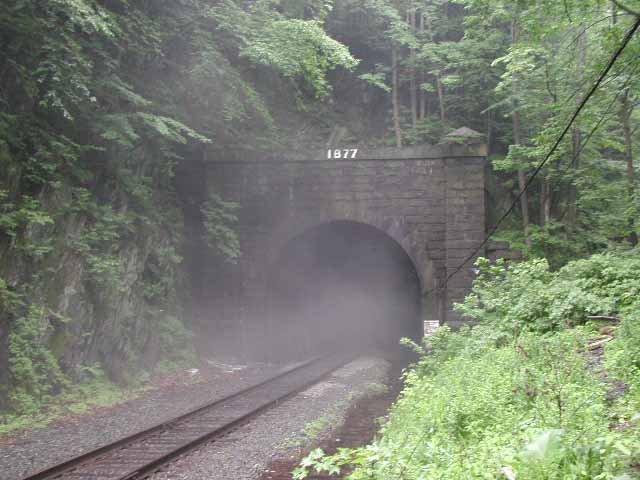
East Portal ~ June 2002
It was a sunny day, and we made the surprising
discovery that a little sunlight goes a long way in a tunnel. After
your eyes adjust to the dark, even the small amount of sun from the
tunnel's opening was entirely enough to light our way, at least dimly.
In fact, we did not even bother with flashlights until we had progressed
well over a mile, and then it was simply to have a look at the
architectural features of the place rather then a need for lighting.
This is not to give the impression that it was well lit, it is just to
say that in my experience, you can walk this tunnel on a sunny day without
a flashlight. I do not recommend this, however.
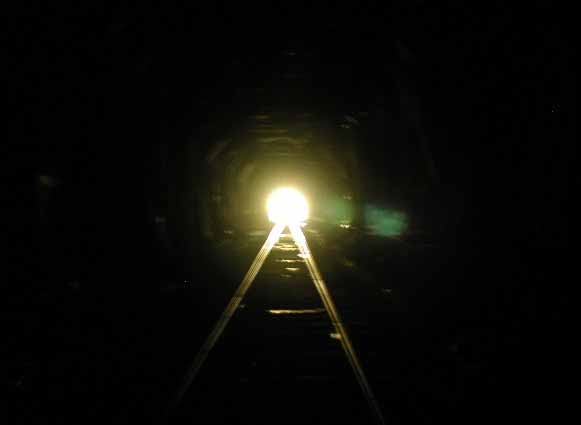
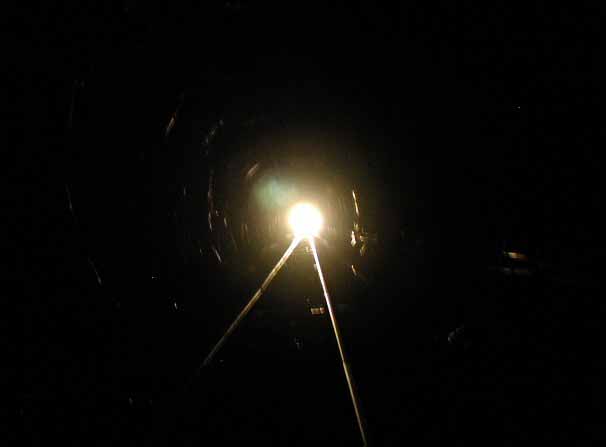
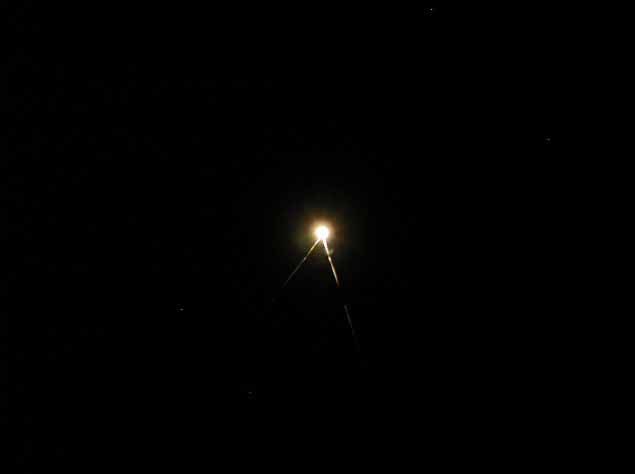
Going, going, gone. . .
the third photo was taken after walking an
hour
First, there are electrical cables running the
length of the southern wall. These are waist height, and conveniently
placed in such a way that if you were to hold them like a had rail you
would also be standing in six inches of water. Not a good idea.
Second, 9.5 miles of railroad tracks is brutal on the feet. And you
really do have to walk on the tracks. The berm to either side is
either crushed rock or inches of muck. The only relatively dry and
stable ground were the tracks themselves. Also, walking between the
rails keeps you from falling off the berm and into the water. We
stumbled a lot. Third, the bricks are collapsing from the bricked
sections of the tunnel. Individual bricks jumping out of the
ceiling. Sheets of brick collapsing out from the walls. Not
that a flashlight will stop them, but you might feel safer.
According to IRONFIST: "Although
not a particularly difficult mission to prepare for, the threat within the
tunnel is real. Large freight
trains pass through at random hours, leaving behind them a potentially
lethal amount of diesel fuel, one hundred year old bricks and archway
supports fall onto the tracks at will, and live electrical wires dance in
the dark."
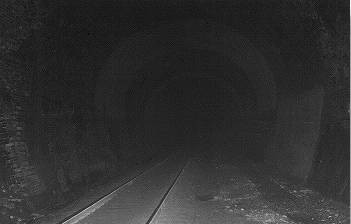
Inside Tunnel ~ Note Brickwork
Photo by Jeff Sumberg
There were many interesting features we noticed
as we went along. Every 200 yards or so there were old field telephones
set in the wall for emergency train use. These were set in alcoves
and lighted. The electrical cables were everywhere, especially on the
south wall, and had the nasty habit of often lying in pools of water.
The brick sections of the the tunnel were particularly interesting.
Central Shaft
After about two hours in we began to hear a mechanical
noise and see a spark of light far ahead. We debated for some time
whether it
was a train not. Thing is, there really is no place to go in the
tunnel in the event of a train. It is a press-up-against-the-wall
and hope for the best situation. The light appeared to be bobbing,
but we eventually realized that this was only a trick of the eye. (Same thing
when you stare at a star at night - it appears to jump around after awhile
due to the optic nerve getting tired.)
After waiting awhile, and noticing that the
light was not getting any brighter, we resumed our journey. The
mechanical noise became louder, and was accompanied by an ever
stiffening breeze. We soon realized we were approaching where the
Central Shaft opens down into the tunnel. There is a large fan
situated 1000 feet up the shaft in the shaft house that draws air out of
the tunnel at great velocity. Both the breeze and the noise were
from the fan.
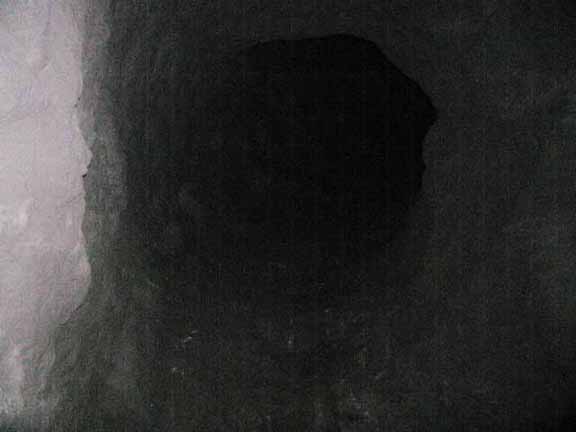
Black Hole of the Central Shaft
The opening to the Central Shaft was a dark hole
curving up into the south side of the tunnel. I have heard that some
technical climbers have tried to climb the shaft, but having had a good
look at it, I would doubt even the nut-jobs at IRONFIST
would try it. Across the tracks from the Central Shaft opening is a
small brick room built into the rock. There were various old pieces
smashed electrical equipment in it. It had a window overlooking the
tracks and perhaps it was a manned station at one point in the tunnel's
history. At the moment it seems to be a destination for the
heartiest of partiers. The graffiti crowd had discovered it too, and
mementos of many a dark journey had been carved in the woodwork and
painted on the walls. One such memento proclaimed that "Ozzy lives
here," presumably this was
before his recent return to stardom and the purchase of that mansion.
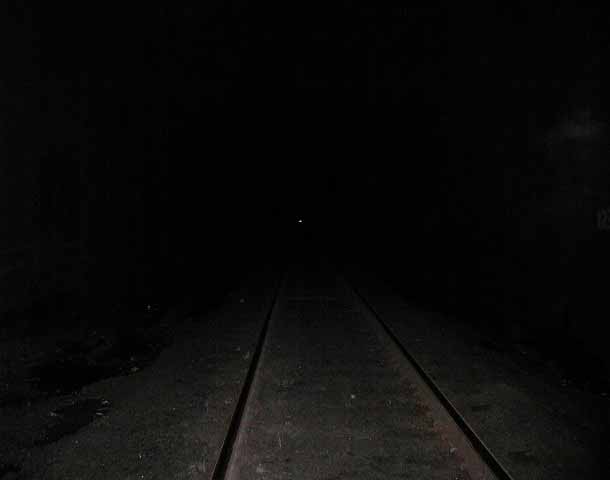
West Portal as seen from Central Shaft
The light we had been seeing turned out to be
the spark of sunlight glinting in from the West Portal opening. Because the track
has a slight grade to each end, with the apex at the middle, we did not
see the West Portal light until we had risen high enough on the grade.
Ghosts
Interesting as all this was, we were here for
spooks, and spooks we demanded. We literally walked the first two
hours in the dark hoping that would be conducive to spook attraction.
After that we lit candles and walked with those. It
was great ambience, those candles - but no spooks. We had heard there
was a place in the tunnel referred to as the "Hoosac Hilton." This
was supposed to be an area where a large section of the tunnel collapsed
killing dozens of workers. It was supposed to be obvious because the
tunnel opens out in a cavernous chamber there. We never found the Hilton. Of course,
we were walking in the dark, but even so we were still able to just make
out the tunnel walls on either side, and I swear we never came to an area
where the tunnel opened out into a large chamber area.
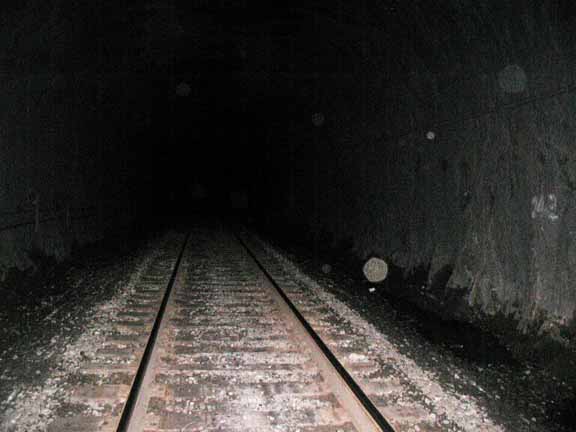
Spirits of the Damned?
Several times during the first two hours I took
pictures in the dark to see if anything spooky would like to show itself
on film.
Nobody that I am aware of decided to pose, but I did get one photo of some
interesting specks and globes of light that appear to be floating in the
tunnel. Are these souls of the dearly departed?
Still haunting the site of their gristly and untimely demise? Or
just . . . specks?
West Portal
The walk from the Central Shaft to the West
Portal seemed to take forever, and I have since learned that indeed - it is a
longer walk than the East Portal section. And, the West half is the wet
half. Water everywhere. Water gushing out of the walls, water
raining out of the ceiling, water filling both sides of the tracks.
And of course the mud. Not just any mud, but disgusto-mud mixed with
decades of soot and cinders. It dried on my boots like cement.
We slogged our way to the West Portal.
This end has an interesting feature - a huge garage door. I kid you
not. This door is such that it can roll down and completely cover
the West Portal opening. I have since heard it had something to do
with snow getting in or "keeping the bears out," but it seems rather unlikely. Frankly, I have no
idea why it is there.
However it does bring to mind an entry from a
ghost-hunting website that has long since died of shame. Apparently
four intrepid ghost hunters, two men and their girlfriends approached the
West Portal in broad daylight one winters day. They felt "chills"
from the "bad vibes." After much coaxing by the girlfriends, the two
men entered the West Portal and went several dozen feet. It was
there they heard the sounds of "body bags falling from the ceiling", and
ran back to the womenfolk. What body-bags falling from the ceiling
sound like, I don't know, but perhaps they had prior experience with this.
All of which brings to mind the wife of friend who walked part of the old
RR tunnel in Clinton, and who also reported "body-bags."
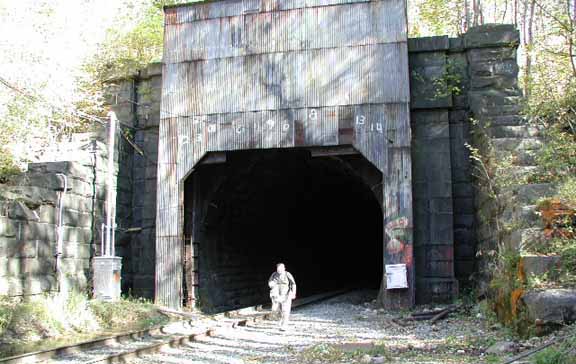
Andy at the West Portal
I was starved and had been looking forward to
lunch at the West Portal. Andy had promised to bring lunch. We
climbed up on the granite foundations of the portal and opened our packs.
Andy took out a candy bar and ate it. Then he had some water.
That was it - no lunch was forthcoming from the pack. I watched him
eat the candy bar. I thought hard bitter thoughts. I wondered
if a train came through if he would get pushed in front of it.
More Ghosts?
The walk back was a cold, wet, and hungry one.
After about several hours on the return walk we noticed that the light from the
West Portal seemed to have a different gleam to it - it didn't seem right.
After some observation we finally realized that it was incandescent and
coming towards us - and entirely silently. Was it the spooks at
last?
We looked for a place to hide in the event it
was a train. Somehow I had the feeling we probably were not supposed
to be in the tunnel, and felt it was probably best not to be seen.
There really was no place to hide though - just tunnel. However,
where the brick sections butted up against the non-brick sections, there
was a slight recess into the wall of about a foot. We decided to
scrunch back into the recess and await events. Events turned out to be one
of those railroad company pickup trucks - the kind that are adapted to
ride on the tracks. It had its bights on and seemed virtually
silent. We pressed into the recess and watched it glide by, barely
an arms length away. I can't imagine they didn't see us.
Comin' Through!
We continued our journey back, quickening the
pace. We passed the Central Shaft section and after awhile could
again see the spark of light from the East Portal. We also noticed a red
light. At this point neither of us equated lights with spooks, but
with railroad personnel. We watched and waited and found another
recess. Our efforts were rewarded with the realization that we had a
freight train approachin'. It came on real slow. They must not
go any faster that 10 or 15 miles per hour in the tunnel. The entire
tunnel began to vibrate hideously long before it got to us. When it
did get to us even the rock was shaking and I wondered why the bricks
didn't all fall as I pressed up against the wall. After the engine
went by it was completely dark, and quite a sensation hearing car after
car slam and rattle by only an arms length away in the pitch dark.
Once the train passed, we had new developments -
we could no longer see the light from the East Portal. It was like
something was blocking the end of the tunnel. As we
continued walking we gradually began to see the portal light again and realized that there was
so much black diesel exhaust fumes from the train that it completely
blocked all the light.
To quote again from N. H. Eggleston in the March
1882 Atlantic Monthly (about how a perpetual cloud of smoke from up
to forty trains a day made it impossible to see more than a few yards in the
in either direction when in the tunnel): "No artificial light, not even the
headlights of the locomotives, can penetrate the darkness for any
considerable distance. The engineer sees nothing, but feels his way
by faith and simple push of steam through the five miles of solemn gloom.
If there is any occasion for stopping him on his way through the thick
darkness, which may almost literally be felt, the men who constantly
patrol the huge cavern to see that nothing obstructs the passage, do not
think of signaling the approaching train in the common way. They
carry with them powerful torpedoes, which, whenever there is occasion,
they fasten to the rails by means of screws. The wheels of the
locomotive, striking these, produce a loud explosion, and this is the
tunnel signal to the engineer to stop his train."
Our final adventure over for the day, we walked
out of the tunnel about an hour later, grimed from head to toe.
Those walls were as sooty as a chimney.
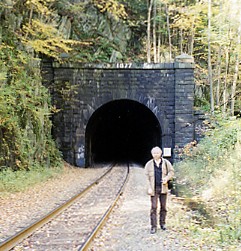
Footsore and Hungry
Photo by Andy Bowers
Observations & Mysteries:
The tunnel is a gritty, dirty, cold and muddy
place, and physically taxing. Freight trains blast through on
regular basis. Electric cables lie in pools of water. There is
no lunch anywhere. If you enjoy such adventures, you are
there. It is not for the timid or casual hiker. The brave lads
from the Ghost-Hunters website only got 30 feet, in broad daylight,
before scampering off in fear.
Some things remain mysteries. We were
unable to locate or verify the Hoosac Hilton. There were certainly
many fatal cave-ins involved in the making of the tunnel, but it seems odd
that one of this supposed size and loss of life has gone unrecorded.
Neither did we find any trace from the inside of the tunnel of the old
West Shaft. Nor have we located the exact site of the shaft head on
the mountain side. Was the shaft entirely filled, or simply capped
and bricked off at both ends? Also, the "Hidden Room of Hoosac"
remains a mystery. Its unspeakable horror still remains unspeakable.
As for spooks, I was quite disappointed. I
guess evil had the day off. Even walking most of the tunnel with no
light whatsoever was not enough to entice the damned for a picnic in the
crypt. I guess they knew there would be no lunch. . . .
Helpful Tips:
First and foremost, any trip into the tunnel
should be approached as a spelunking adventure, and with all the necessary
precautions. The tunnel is like a cave that at its deepest point is
2.5 miles from an entrance - not a good place to be if things go wrong.
According to the camy-clothed para-wieners of IRONFIST: "Despite what many
believe about the Hoosac Tunnel, it is not as simple an operation as it
seems. The
IRONFIST expeditionary team has had years of practice in the most
difficult of situations and questionable locales such as the Hoosac Tunnel
and has therefore honed their skills like none other. Their
classification of the Hoosac Tunnel as 'easy' should not be taken
literally, as the group has encountered many dangers within, including
trains, noxious gases, and unfriendly locals."
If you go round trip, expect the journey to take at least 6
hours. Bring a small "AA" Mini-MagLight style flashlight. You don't
need a big one and it will only strain your arm carrying it for 6 hours.
Bring a spare Mini-MagLight and several sets of reserve batteries. Be careful
about your light - railroad personnel in trucks and on foot can see a
flashlight real well in the tunnel. Wear a hardhat. One falling
brick could possibly kill you. And falling bricks are a real hazard.
Its cold in there, bring an extra sweater for your pack. Wear waterproof
footwear - and remember, whatever you wear you will be wearing for a jarring
10 mile hike. And, the diesel exhaust fumes could be life-threatening
in that confined space. Of course, you won't need any of my advice if
you are one of those nut-jobs from IRONFIST.
Links and References:
East Portal: Head west on Route 2 (Mohawk
Trail) to the center of the town of Florida. One half mile before the
Eastern Summit, take a right on Church Road, a steep dirt road. At the
bottom take a right onto Whitcome Hill Road. Take a left on River Road
at the Deerfield River. About one half mile or more on the right is a
railroad crossing. The East Portal is up the tracks on the left.
West Portal: Head west on Route 2 (Mohawk
Trail) past the
Western Summit. West Shaft Street is on the left about 1.5 miles
past the hairpin turn. The West Portal is not observable from the road.
You will need to park on the right just before where the road bends right and
goes down into North Adams. The West Portal is 3/10ths of a mile due
west through the woods.
Central
Shaft, Shaft Head & Fan Building: Head west on Route 2
(Mohawk Trail) through the town
of Florida. Central Shaft Road is on your left about 2 miles past
Whitcomb Summit. The shaft-head
fan building is about 1.5 miles on the left.

Central Shaft Head & Fan Building
Photo by Jeff Sumberg
Websites:
Jerry "Ringo" Kelley presents
The Hoosac Tunnel: Now and
Then
The most comprehensive Hoosac Tunnel
website.
An article from Scribner's
December 1870 issue:
Building the Hoosac
Tunnel
Hoosac Tunnel Vintage Postcard Picture Gallery:
Hoosac Tunnel
History and Haunting of America:
Ghosts of the Bloody
Pit
Facts & Stats about the
Hoosac Tunnel
Books:
A
Pinprick of Light: The Troy and Greenfield Railroad and Its Hoosac Tunnel
by Carl R. Byron
About the
Authors:
Neither Dan
or Andy are nut-jobs from IRONFIST.
To boudillion.com Home Page
Field
Journal
Copyright © June 2003 by Daniel V. Boudillion
|